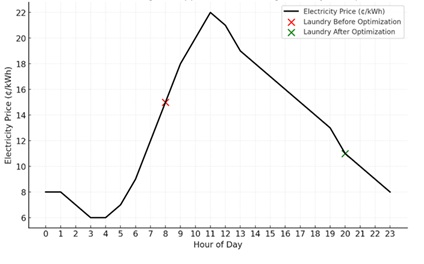Optimizing Household Energy Consumption Using Numerical Approaches to Reduce Costs and Environmental Impacts
DOI:
https://doi.org/10.63876/ijss.v1i3.14Keywords:
Household Energy Optimization, Numerical Methods, Energy Efficiency, Cost Reduction, Environmental Impact ReductionAbstract
In an effort to face the challenges of increasing global energy consumption and its environmental impacts, optimizing energy use in the household sector is one of the important solutions. This article proposes a numerical approach to optimize household energy consumption with the aim of reducing costs and environmental impacts. Through mathematical modeling and simulation, this method evaluates the energy use of household electrical devices, and analyzes efficient energy consumption patterns. The results of the study show that the implementation of this optimization strategy can reduce energy costs by up to 20% and reduce carbon emissions, thus supporting environmental sustainability. This approach can be applied by both urban and suburban households, making a significant contribution to green energy initiatives and national energy-saving policies.
Downloads
References
S. Yang et al., “Flexibility index for a distributed energy system design optimization,” Renew. Energy, vol. 219, p. 119423, Dec. 2023, doi: 10.1016/j.renene.2023.119423.
H. Sahebi, H. Ashenaei, S. Mirzamohammadi, and H. Gilani, “Reducing passenger waiting time and energy consumption for metro timetabling: A robust optimization approach,” Energy Reports, vol. 10, pp. 4051–4062, Nov. 2023, doi: 10.1016/j.egyr.2023.10.063.
F. Wang, T. Wei, S. Cheng, L. Zhuang, and S. Lan, “How does early-life famine experience influence household energy transition?,” Heliyon, vol. 9, no. 12, p. e22708, Dec. 2023, doi: 10.1016/j.heliyon.2023.e22708.
M. A. A. Abdalla, W. Min, W. Bing, A. M. Ishag, and B. Saleh, “Double-layer home energy management strategy for increasing PV self-consumption and cost reduction through appliances scheduling, EV, and storage,” Energy Reports, vol. 10, pp. 3494–3518, Nov. 2023, doi: 10.1016/j.egyr.2023.10.019.
G. Trotta, “Electricity awareness and consumer demand for information,” Int. J. Consum. Stud., vol. 45, no. 1, pp. 65–79, Jan. 2021, doi: 10.1111/ijcs.12603.
C.-C. Lee, H. Song, and C.-C. Lee, “Assessing the effect of green finance on energy inequality in China via household-level analysis,” Energy Econ., vol. 128, p. 107179, Dec. 2023, doi: 10.1016/j.eneco.2023.107179.
E. Garabitos Lara, A. Vallejo Díaz, and C. N. Pereyra Mariñez, “Electrical dataset of household appliances in operation in an apartment,” Data Br., vol. 51, p. 109742, Dec. 2023, doi: 10.1016/j.dib.2023.109742.
R. Prieler et al., “Fire resistance of gypsum-sheathed stud walls with an embedded steel door: Validation of a numerical approach,” Fire Saf. J., vol. 141, p. 103922, Dec. 2023, doi: 10.1016/j.firesaf.2023.103922.
M. Gaši, B. Milovanović, D. Tkalčić, and M. J. Rukavina, “Thermal transmittance of a composite lightweight wall panel with integrated load-bearing structure: Experimental versus numerical approach,” Case Stud. Constr. Mater., vol. 19, p. e02631, Dec. 2023, doi: 10.1016/j.cscm.2023.e02631.
A. Angelis-Dimakis et al., “Methods and tools to evaluate the availability of renewable energy sources,” Renew. Sustain. Energy Rev., vol. 15, no. 2, pp. 1182–1200, Feb. 2011, doi: 10.1016/j.rser.2010.09.049.
F. Shrouf, J. Ordieres-Meré, A. García-Sánchez, and M. Ortega-Mier, “Optimizing the production scheduling of a single machine to minimize total energy consumption costs,” J. Clean. Prod., vol. 67, pp. 197–207, Mar. 2014, doi: 10.1016/j.jclepro.2013.12.024.
Y. Li, B. Zhang, Z. Liu, and R. Wang, “Neural energy computations based on Hodgkin-Huxley models bridge abnormal neuronal activities and energy consumption patterns of major depressive disorder,” Comput. Biol. Med., vol. 166, p. 107500, Nov. 2023, doi: 10.1016/j.compbiomed.2023.107500.
S. MacAskill, S. Becken, and A. Coghlan, “Engaging hotel guests to reduce energy and water consumption: A quantitative review of guest impact on resource use in tourist accommodation,” Clean. Responsible Consum., vol. 11, p. 100156, Dec. 2023, doi: 10.1016/j.clrc.2023.100156.
L. Jin and C. Zhang, “Process Planning Optimization With Energy Consumption Reduction From a Novel Perspective: Mathematical Modeling and a Dynamic Programming-Like Heuristic Algorithm,” IEEE Access, vol. 7, pp. 7381–7396, 2019, doi: 10.1109/ACCESS.2018.2889882.
Y. Cui, Z. Geng, Q. Zhu, and Y. Han, “Review: Multi-objective optimization methods and application in energy saving,” Energy, vol. 125, pp. 681–704, Apr. 2017, doi: 10.1016/j.energy.2017.02.174.
K. Zhou and S. Yang, “Understanding household energy consumption behavior: The contribution of energy big data analytics,” Renew. Sustain. Energy Rev., vol. 56, pp. 810–819, Apr. 2016, doi: 10.1016/j.rser.2015.12.001.
W. R. Dean and J. R. Sharkey, “Rural and Urban Differences in the Associations between Characteristics of the Community Food Environment and Fruit and Vegetable Intake,” J. Nutr. Educ. Behav., vol. 43, no. 6, pp. 426–433, Nov. 2011, doi: 10.1016/j.jneb.2010.07.001.
S. J. T. Jansen, “Urban, suburban or rural? Understanding preferences for the residential environment,” J. Urban. Int. Res. Placemaking Urban Sustain., vol. 13, no. 2, pp. 213–235, Apr. 2020, doi: 10.1080/17549175.2020.1726797.
I. Khan, “Household factors and electrical peak demand: a review for further assessment,” Adv. Build. Energy Res., vol. 15, no. 4, pp. 409–441, Jul. 2021, doi: 10.1080/17512549.2019.1575770.
S. Hambridge, N. Lu, A. Q. Huang, and R. Yu, “A frequency based real-time electricity rate for residential prosumers,” in 2017 IEEE Power & Energy Society General Meeting, 2017, pp. 1–5, doi: 10.1109/PESGM.2017.8273834.











